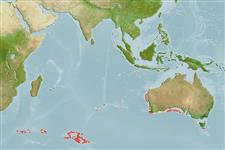Klassifizierung / Names
Namen | Synonyme | Catalog of Fishes(Gattung, Arten) | ITIS | CoL | WoRMS | Cloffa
Elasmobranchii (Haie und Rochen) (sharks and rays) >
Squaliformes (Sleeper and dogfish sharks) >
Centrophoridae (Gulper sharks)
Etymology: Centrophorus: centr[um] (L.), prickle or sharp point; phorus, from phoreus (Gr.), bearer or carrier, referring to grooved spines on dorsal fins (See ETYFish); westraliensis: -ensis, Latin suffix denoting place: Western Australia, only known area of occurrence (See ETYFish).
Environment: milieu / climate zone / depth range / distribution range
Ökologie
seewasser bathydemersal; tiefenbereich 616 - 750 m (Ref. 76933). Tropical
Eastern Indian Ocean: Western Australia.
Size / Gewicht / Alter
Maturity: Lm ? range ? - ? cm
Max length : 90.9 cm TL (female)
Kurzbeschreibung
Bestimmungsschlüssel | Morphologie | Morphometrie
This moderate-sized species has the following set of adult characters: length of pre-second dorsal 63.8-64.9% TL, 8.8-9.7 times dorsal-caudal space; length of pre-first dorsal 31.3-32.7% TL; interdorsal space 20.3-21.5% TL, 2.8-3.1 times dorsal-caudal space; dorsal-caudal space 6.7-7.3% TL, 4.4-4.9 in pectoral-pelvic space; long and moderately robust head, its length 23.2-24.7% TL, 3.1- 3.2 times mouth width, its width 11.7–12.8% TL, 5.1-5.5 in pre-second dorsal length; width at anterior of nostrils 7.1-7.6% TL; long snout, its preoral length 10.9-12.4% TL, 2.0-2.2 times head height at anterior of mouth, 1.4-1.6 times mouth width; horizontal preorbital length 7.0-7.8% TL; horizontal prenarial length 4.5-4.9% TL; moderately large mouth, its width 7.6–7.8% TL; large pectoral fin, its anterior margin 12.9-14.2% TL, 2.6-2.8 times base length; large caudal fin, its dorsal caudal margin 17.4-20.2% TL; 2.6-2.9 times dorsal-caudal space; moderately-sized first dorsal fin, its height 5.5-6.4% TL, with relatively robust spine, its base width 1.1-1.2% TL; dorsal fins of juveniles have a distinct blackish oblique blotch anteriorly and a white blotch on the upper posterior margin; in adults a less distinct dark blotch which is usually still apparent in fresh specimens and with white blotch restricted to a narrow white posterior margin which can be indistinct in larger preserved specimens; females and an immature male with upper teeth strongly oblique, similar in shape, but much smaller than lower teeth; 38/29.teeth count in holotype; adults with flank denticles flat, not overlapping, with scalloped edges; 112-117 (mean 115.3) total vertebral centra; 55-57 (55.8) monospondylous precaudal centra; 29-33 (31) diplospondylous precaudal centra; 85-88 (86.8) precaudal centra; 27-30 (28.5) diplospondylous caudal centra (Ref. 76933).
Life cycle and mating behavior
Geschlechtsreife | Fortpflanzung | Ablaichen | Eier | Fecundity | Larven
White, W.T., D.A. Ebert and L.J.V. Compagno, 2008. Description of two new species of gulper sharks, genus Centrophorus (Chondrichthyes: Squaliformes: Centrophoridae) from Australia. pp. 1-21. In P.R. Last, W.T. White and J.J. Pogonoski (eds). Descriptions of new Australian chondrichthyans. CSIRO Marine and Atmospheric Research Paper no. 22. 365 p. (Ref. 76933)
IUCN Rote Liste Status (Ref. 130435: Version 2024-2)
Bedrohung für Menschen
Harmless
Nutzung durch Menschen
Tools
Zusatzinformationen
Download XML
Internet Quellen
Estimates based on models
Preferred temperature (Ref.
123201): 1.7 - 8.2, mean 6.9 °C (based on 11 cells).
Phylogenetic diversity index (Ref.
82804): PD
50 = 0.5001 [Uniqueness, from 0.5 = low to 2.0 = high].
Bayesian length-weight: a=0.00245 (0.00116 - 0.00519), b=3.20 (3.02 - 3.38), in cm total length, based on LWR estimates for this (Sub)family-body shape (Ref.
93245).
Trophic level (Ref.
69278): 4.3 ±0.3 se; based on size and trophs of closest relatives
Widerstandsfähigkeit (Ref.
120179): sehr niedrig, Verdopplung der Population dauert mehr als 14 Jahre. (Preliminary K or Fecundity.).
Fishing Vulnerability (Ref.
59153): High vulnerability (56 of 100).
